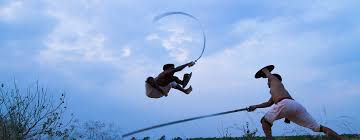South Asian Martial Arts: Sqay
- Amir Hamza
- Jul 12, 2020
- 4 min read
Heading over to another Muslim country in South Asia. We are in Pakistan. Well more specifically the disputed territory of Kashmir which is fought over by Pakistan and India. But regardless of borders and political issues. We are here in the great north of the country to look at another martial art. This one is the weaponry focused Sqay.

Martial Art: Sqay
Style: Weaponry
Country: Pakistan
Origin: Kashmir

History: Sqay is a Kashmiri martial arts that specialises in using sword/stick (Turo) and a shield (Bargula). Armed Sqay uses curved single edged sword and shield or dual wielded swords. Unarmed techniques used Kicks, Punches, locks and knife hand chops. The Earliest origins of the martial art Sqay is unknown, due to lack of paper based evidence. Most of the art earliest history was shared by word of mouth over the generations with some believing the art exist for at least 1000 years. Some myths believe that the style existed even as early as the deluge myths or even brought over by the Snake worshipping Naga peoples. Regardless of believed origin. The earliest tangible evidence of this martial arts existence comes from the Iranians in the 1500s. They referred to the art as either Shamsherizen or Sqay (the latter word meaning Knowledge of War in Persian). The practice of the style began to decline during Colonialism around the 1800s and even further more during the Kashmir Conflict in the 1900s. Around the 1980s Grandmaster Mir Nazir Ahmed had concerns the art would go extinct so introduced modern less lethal aspects to the art for more light competition based training as seen from influential styles from Taekwondo to Karate. Outside of Pakistan, the style has been practice across South Asia (India, Bangladesh, Nepal, Bhutan specifically) and also to other regions of Asia on a smaller scale like West Asians Nations like Jordan, Syria, Turkey, Azerbaijan, Iran, Iraq and Georgia. South East Asian Nations like Malaysia, Indonesia, Thailand and in Central Asian country Uzbekistan.
Culture: Sqay Competitions typically practices three things: Sparring, Breaking and Forms. Sparring (Loba) takes place in a 5-6.5 metres square. Fighters are matched by age and weight. A Dre (equal to 3 points) is awarded for a Mavashi Kick (kick to side of headguard). A Dha (2 points) are awarded for a successful Maygiri kick (to the stomach). A Yaw (1 point) is awarded for a successful hit with the Tora (Stick). However a fighter can be penalised for use of excessive force. Legal targets in Sqay are the arms, legs, head and upper body. Forbidden targets are the eyes, groin, hips, knee and uncover skin areas. Penalties are given for Kokodays (Ring-outs), dropping the sword or shield or striking a forbidden target. A Muko (first warning) penalties 1.5 points, a repeat offense leads to Dasi Muko (strong warning) penalties 3 points, and the final offense leads to Owaza (Disqualification). A bout can last around 3-7 minutes and 9 points is the maximum number a fighter can get to be declared the victor. For breaking (mathol) demonstrations, fighters are judged on technique, form, quantity of items and how clean the items are broken. Glass is prohibited but breaking Wood or Stone. Individuals are scored in scales of 10. Forms (Khawankay) are very similar to Tuls in Taekwondo or Katas in Karate. Practitioners do have limits in sparring but in their forms they have more variety in what techniques they can use or demonstrate. They are judged on stance, timing and perfection of form.
Warrior: Traditionally in before colonialism. Sqay utilises Shield and swords. Much like many ancient form of martial arts. This was lethal but overtime had become a softer and light contact martial arts. As a result the sword in modern competitions are replaced with a stick and shield made from synthetic fibres covered in leather. The sword can be up to 2-2.6 metres long and the shield is around 25 cm or 10 inches in diameter. Official uniform of the fighters are blue trousers and cross front jackets sometimes with red or yellow piping and a belt around the waist. Fighters are required to wear chest and heads guard for sparring.

Media/Potential: Sqay has not had a lot of representation or attention in popular media despite its alleged growth and revival as a modern style. Assassin's Creed chronicles does have character of the name Arbaaz Mir a Muslim assassin from Kashmir during Colonial times. Many of the weapons and techniques he uses are likely a mix of Sqay (befitting his Kashmiri heritage) along with some other styles as his use of throwing a razor sharp hoop/disc called a Chakram indicates his had practiced other South Asian styles too. There is also a vague character within SNK's ranks that is allegedly a Sqay fighter. Art of Fighting 3 introduced Sinclair. Despite the Scottish name, Sinclair is defined as being vaguely middle eastern and a practitioner of either sword fighting or Kenjutsu. However on the SNK Wikia and the TV tropes website Sinclair's sword stance and style is believed to take visual cues from traditional armed Sqay. TV Tropes website even states her style is Sqay instead of just a generic sword/Scimitar style. Maybe games like Soul Calibre or Samurai Showdown could create a Pakistani Sqay fighter. Considering Tekken's recent world champion Arslan Ash is from Pakistan. Tekken producer Katsuhiro Harada maybe considering a potential Pakistani character for a future Namco fighting game most likely for either Tekken or Soul Calibre as a way to honour Arslan Ash's country.



Comments